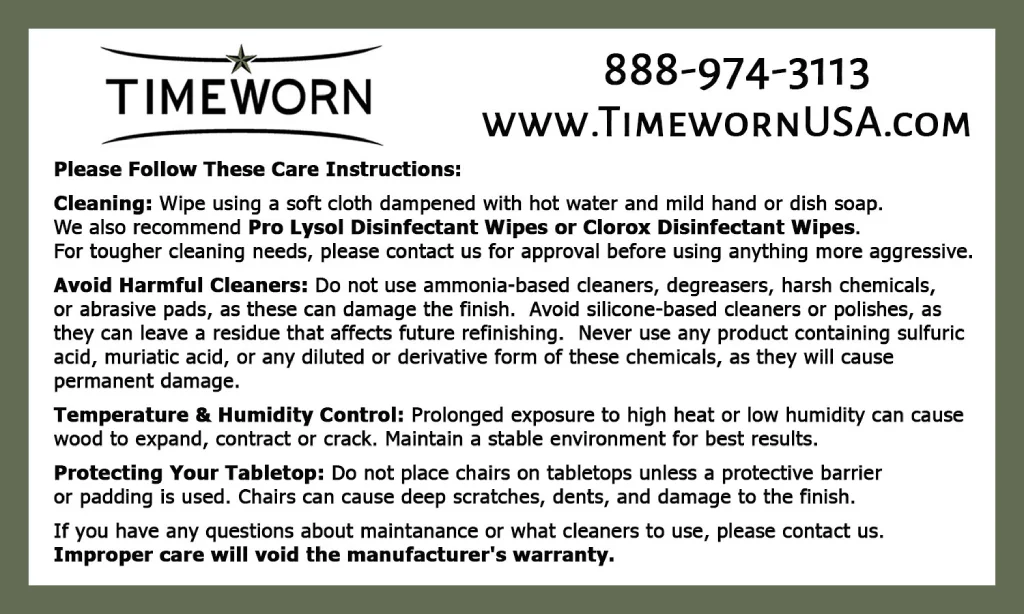When it comes to creating the perfect dining experience, few elements matter more than the restaurant table tops your guests use every day. Restaurant table tops set the tone for your space, dictate how long furniture will last, and can even impact how comfortable and safe guests feel. Choosing the right tabletops is about much more than solid wood vs laminate—it’s about durability, aesthetics, maintenance, and long-term return on investment.
At TimeWorn, we’ve spent over 15 years manufacturing custom restaurant tables that withstand the daily demands of high-traffic dining. In this guide, we’ll break down everything you need to know before investing in restaurant tabletops in 2025.
Why Restaurant Table Tops Matter
Your tables are one of the very first things guests notice when they sit down, and they play a bigger role than most owners realize. They set the tone for your brand — whether that’s modern and refined, rustic and welcoming, or high-energy and communal — and they immediately signal the level of care you put into your dining experience. The wrong table tops can wear out quickly, forcing you into costly replacements, or worse, they can look cheap and clash with your restaurant’s design. Poor sizing or layout decisions can also create ADA compliance problems and make guests feel cramped or uncomfortable. Well-designed tables, by contrast, create an inviting atmosphere, maximize your seating capacity, and make every diner feel more at ease. They’re not just furniture — they’re functional design tools that directly impact how long guests stay, how comfortable they are, and how they remember their visit.
Key reasons to prioritize your tabletops:
- First impressions: Tables set the aesthetic tone of the dining room.
- Longevity: Durable tabletops reduce replacement cycles.
- Compliance & safety: Proper sizing and spacing ensures ADA accessibility and guest comfort.
- Return on investment: Higher-quality tables last longer, saving money over time.
Standard Sizes & Seating Capacity
Restaurant table tops are produced in a wide range of standard sizes, but choosing the right dimensions impacts not only how many guests you can seat but also how comfortable they feel. To make this easier, we’ve created two detailed drawings that cover 32 of the most common table sizes — including rounds and drop-leaf options.
The first drawing provides seating recommendations for bar and quick-service restaurants, where layouts typically allow about 18″ per guest. The second drawing is designed for casual and fine dining establishments, where 24″ per guest is the standard for comfort and service. Both drawings clearly indicate how many guests we recommend seating at each table size, giving you a quick reference for planning.
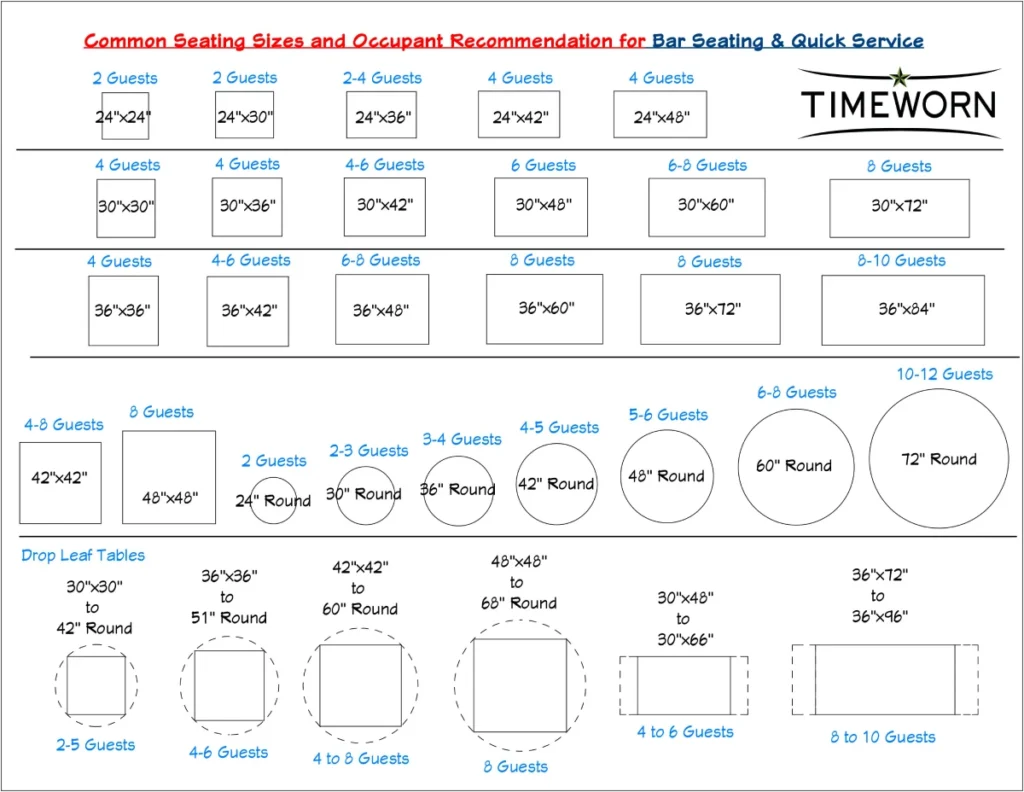

Always account for ADA accessibility, leaving at least 36″ of clearance in pathways, and consider a mix of small two-tops and larger communal tables to maximize flexibility. With our degrees in interior design and architecture — combined with our experience working on more than 3,000 restaurants nationwide — we know how to balance design, comfort, and efficiency. If you’d like help optimizing your own layout, you can contact us directly and we’d be glad to walk through your project.
Best Wood Species for Restaurant Table Tops

Not all wood is created equal—especially in a commercial dining setting. Below are the most popular species we source at TimeWorn, paired with thoughtful craftsmanship techniques that elevate both durability and aesthetics:
- Walnut: A premium choice with deep, rich tones and smooth grain. Ideal for upscale venues. We finish it with our two-part acrylic polyurethane matte system to enhance chemical and heat resistance.
- White Oak: Known for its timeless beauty and exceptional wear resistance. We primarily use quarter-sawn white oak for its enhanced stability and durability.
- Maple: Affordable and clean in appearance. Popular in modern designs. Our quick-ship maple tabletops showcase its lighter coloring and smooth texture with ease.
- Ash: Strong with a straight grain and classic appeal. A great value option for high-use areas.
- Reclaimed Oak or Pine (Barn Wood): Offers rustic charm, unique character, and environmental benefits. Our reclaimed materials are kiln-dried to below 5% moisture and fully lead-free.
Tip: Try mixing species across different zones—walnut for dining areas, reclaimed oak for bars—to balance aesthetics and budget while maintaining visual continuity.
Types of Table Tops
When it comes to restaurant furniture, the construction method and surface texture of your tables matter just as much as the wood species. At TimeWorn, we classify our solid wood table tops by how they’re built, the width of the staves, and the level of texture each style brings to your space:

- Butcher Block – Built from 100% quarter-sawn wood, butcher block tops highlight tight, consistent grain patterns that are as durable as they are beautiful. The staves are narrow (around ¾″ wide), giving the surface a clean, uniform appearance. This style is exceptionally strong and holds up to years of high-traffic use.
- Classic – A TimeWorn signature. Also constructed of 100% quarter-sawn wood, but with slightly wider 1¼″ staves. This creates a timeless look with visible ray flecking and “tiger striping” unique to quarter-sawn lumber. It’s one of our most requested styles because it blends elegance with unmatched stability.
- Distressed – Featuring 1½–2″ wide staves, distressed tops showcase intentional character marks like saw kerfs, knots, and chatter. They bring a sense of warmth and history to a space, making them popular in breweries, pubs, and rustic-themed restaurants.
- Mixed Plank – Constructed from wider boards, typically 3–5″ staves, this style delivers a bold, casual aesthetic. Mixed plank tables often highlight natural color variation between heartwood and sapwood, making each top visually unique.
- Rustic Patina – Another TimeWorn original, coined over 15 years ago. Rustic Patina tops retain evidence of their sawmill origins, with rough-sawn textures left intentionally on the surface. This style embraces imperfection, giving each table a hand-crafted authenticity that can’t be replicated.
- Standard Plank – Once the industry standard, this style is built from quarter-sawn wood with 1½–2″ staves. We introduced the name over 15 years ago, and it remains a reliable choice for operators who want a balance of traditional looks and proven durability.
Other Materials (and Why We Don’t Recommend Them)
- Laminate – A thin sheet of plastic bonded to particle board. It scratches, peels, and looks cheap.
- Veneer – A thin wood layer glued to particle board. Susceptible to bubbling, chipping, and failure under moisture.
- Stone – Heavy, cold to the touch, and prone to cracking in busy restaurant settings.
At the end of the day, solid wood remains the gold standard. It delivers the warmth, durability, and premium aesthetics that operators, designers, and guests all notice — and when properly finished, it easily outlasts cheaper substitutes. Here is a comparison table including all your restaurant table top options, not just wood:

Custom Shapes & Specialty Table Tops
Not every restaurant table is a simple rectangle. Custom shapes not only solve functional challenges but also enhance your guests’ overall dining experience. The right design can improve traffic flow, maximize capacity, and create comfort for both guests and staff.
Booth Tables
Booths are one of the most space-efficient and comfortable seating options in restaurants. To manufacture a tabletop that fits perfectly, we’ll need precise measurements directly from your booth manufacturer, including:
- Inside booth width and depth (measured cushion-to-cushion).
- Clearance for table overhang (typically 1½–2″ per side).
- Any radius or angle details on the booth corners.
Accurate dimensions ensure the table top nests neatly, giving guests a seamless dining experience without wasted space or awkward gaps.

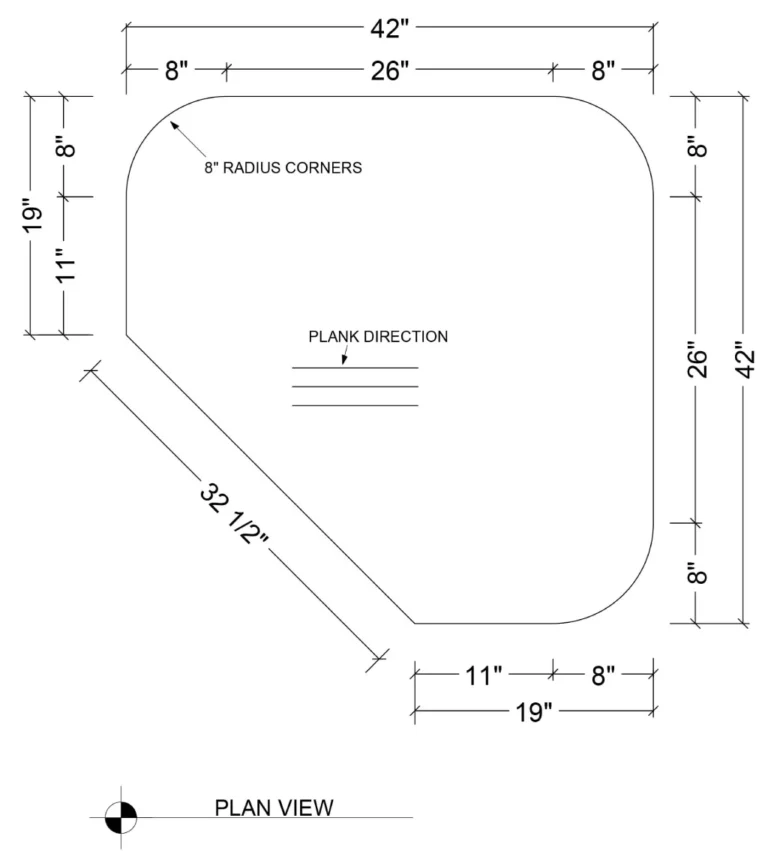
B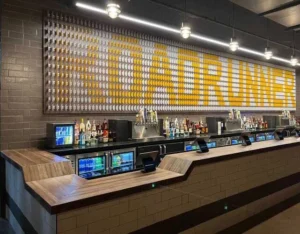 ar Tops
ar Tops
Restaurant Bar tops bring unique requirements because they’re not only functional but often the centerpiece of your establishment. For a flawless build, we’ll need:
- Overall bar length (wall-to-wall or corner-to-corner).
- Bar depth (front edge to wall or drink rail).
- Cutout details (sinks, beer taps, POS stations, ADA drop-downs).
Connection details if the bar will exceed 14′ and need hardware for seamless joins.
The more precise the drawings, the better we can ensure your bar top is manufactured to spec, assembled quickly on-site, and built for long-term durability.
Rounds
Round tables create a sense of intimacy and conversation that rectangular tables can’t match. However, they require more floor space per seat, which can reduce overall capacity in high-volume restaurants. Use them strategically in corners, private dining rooms, or spaces where creating a social vibe matters more than maximizing cover count.
Drop-Leaf Tables
Drop-leaf tables offer unmatched versatility—ideal for restaurants that need to adapt seating configurations on the fly. At TimeWorn, our drop-leaf tables are more than space-savers; they’re crafted from premium solid wood and designed to enhance both form and function.
Space-Savvy Design for Any Layout
Our most popular variant is the square-to-round drop-leaf table, which can transform a 36″×36″ square into a 51″ round, comfortably seating 4 to 6 guests. Larger options—like a 48″ square converting to 68″ round—require four legs for rock-solid support. These designs are perfect when you need to quickly accommodate larger parties without rearranging your floor plan.


Stylish Yet Sturdy Construction
Crafted using the same solid woods as our tabletops, these tables effortlessly blend with your design aesthetic while offering long-lasting durability. Every drop leaf is cut with unparalleled accuracy on our CNC, and the 80+ required screws are flawlessly pre-drilled by the CNC as well—ensuring each table is built to absolute perfection and precision. This meticulous process guarantees flawless movement when folding the tables up or down. Hinges and hardware in our drop-leaf models are always commercial-grade metal, built to handle frequent use and movement.
Customizable by Style and Size
Choose from a variety of shapes—square-to-round, extending rectangles, or custom designs to fit your space. Whether you’re outfitting a café, banquet room, or event space, our drop-leaf tables adapt beautifully to your needs.
Perfect For:
- Restaurants with varying traffic levels—expand for busier times, collapse for quieter hours, such as hotels & the hospitality industry.
- Multipurpose areas and catering zones that require both openness and seating.
- Limited-footprint venues like cafés or patios where flexibility is essential.
Design + Operational Considerations
- Extended leaf options may require additional legs for balance and safety.
- Train staff to use and lock leaves first—this avoids wobbling or injury during service.
- Include measurements for both deployed and folded states in your layout plans for clearance, circulation, and cleaning.
A Blend of Elegance and Practicality
Drop-leaf tables are an elegant solution for modern restaurants—they balance flexibility, efficiency, and visual appeal seamlessly. As we say at TimeWorn, they perfectly combine “the versatility of modern design with the quality of timeless craftsmanship”
Edge Profiles & Customization Options
Edge design is often overlooked but directly impacts both comfort and branding.
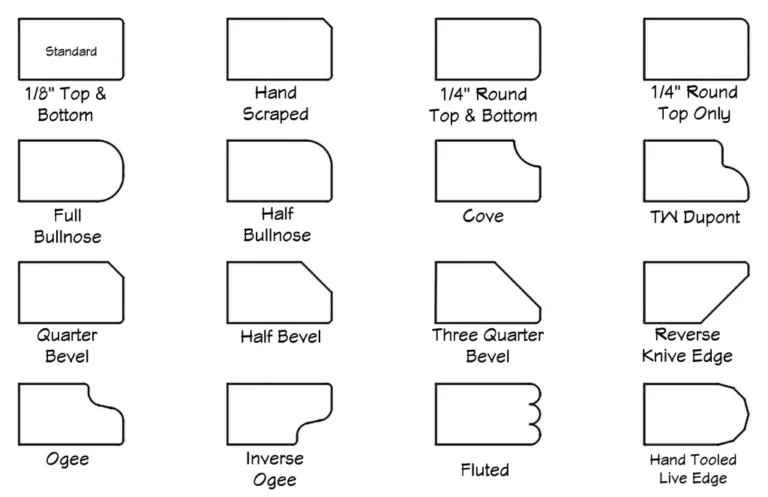
- Standard: Modern and clean.
- ¼” Round Over: Softer, safer, and comfortable for arms.
- Beveled Edge: Adds sophistication and visual flair.
- Reverse Knife Edge: Extremely popular and modern.
- Full Bullnose: Very unique, stands out as the softest option.
- Custom CNC Profiles: Logos, patterns, or unique curves add branding value.
Architects and designers increasingly request, custom tabletop edges, CNC-cut logos or brand marks on restaurant tables as a subtle way to elevate the guest experience.
Finish Systems That Survive Daily Cleaning
Choosing the right finish is even more crucial than the wood itself—especially in the restaurant world where surfaces endure constant cleaning, heat, moisture, and chemical exposure. At TimeWorn, we don’t just build beautiful tables—we engineer them to stay functional and safe for your staff and guests.
Why the finish matters
Sticky, tacky surfaces are more than just annoying—studies and customer feedback show they can impact customer comfort, cleaning routines, and even perception of hygiene. When cleaners and sanitizers degrade the finish, it breaks down, becomes sticky, and looks worn out—potentially harming guest experience and safety. Our goal is to retain that smooth, clean feel day in and day out, so your tables look and function perfectly even under intense use.
Film Finishes (Acrylic Polyurethane)
- Creates a tough, chemical-resistant barrier over the wood that prevents cleaning products, spills, and heat from penetrating—keeping surfaces smooth and non-sticky, even under harsh cleaning routines.
- Superior heat resistance, backed by our internal heat-testing. These finishes protect against repeated exposure to hot plates and beverages without discoloration, warping, or residual stickiness.
- Highly durable and designed for commercial use, ensuring long-term resilience in high-traffic environments.
- Our acrylic polyurethane is SEFA-8 tested—a rigorous certification for chemical and stain resistance in commercial furniture—so you can be confident it will stand up to the toughest restaurant cleaning regimens. To the right is a full list of the professional testing done to our finish and how they performed.
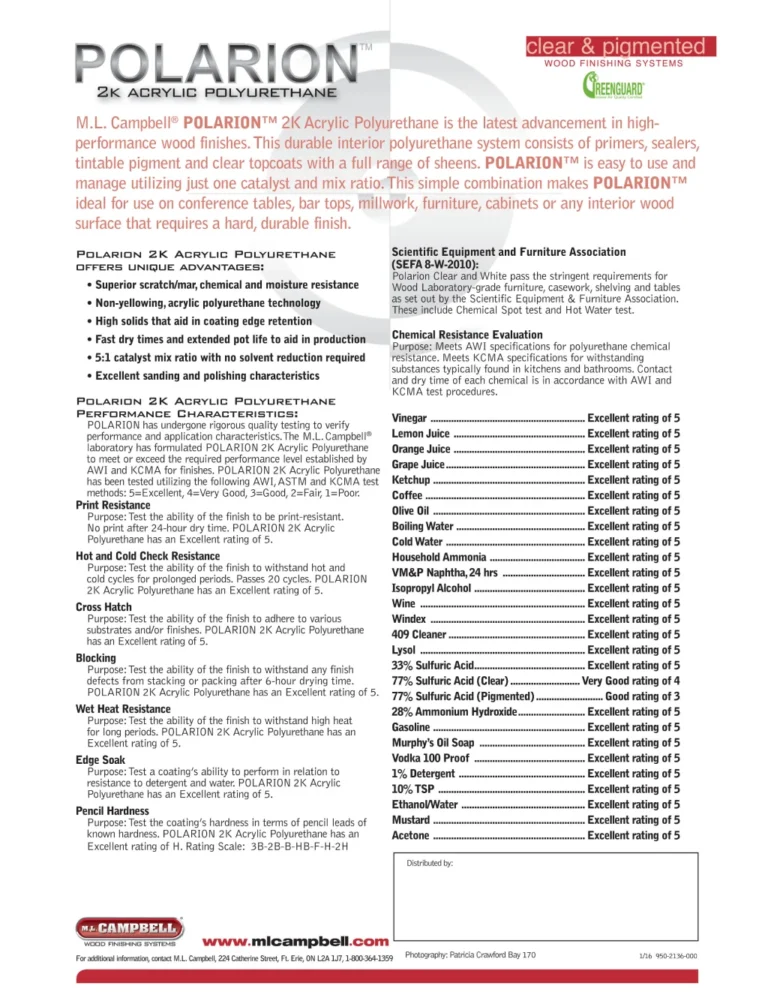
The Problem with Lesser Finishes
Not all film finishes are created equal. Many commercial furniture makers use conversion varnish, precatalyzed lacquer, or lower-end catalyzed varnishes. While they may look good when new, they simply don’t hold up in restaurant conditions:
- Conversion varnish often begins to soften and get sticky under continuous cleaning. Depending on how aggressively the tables are cleaned and what products are used, breakdown typically occurs in 1–4 years.
- Lacquers and some water-based coatings break down even faster, showing wear within months in high-volume restaurants.
- Once these finishes degrade, no amount of cleaning removes the tacky feel—it’s a failure of the finish itself, not the cleaning staff.
This is why TimeWorn relies exclusively on industrial-grade acrylic polyurethane systems that outperform every other film finish available in terms of chemical resistance, heat tolerance, and long-term durability.
Non-Film Finishes (Penetrating Oils)
- Oils like Rubio and Seal-Once absorb into the wood, preserving a natural aesthetic with no film on top—great for spot repair but less protective against heavy-duty cleaning.
- Best for settings seeking a rustic or organic vibe and less aggressive cleaning routines, such as a residential environment.
Why Acrylic Polyurethane Is Our Go-To
- Through years of testing, it outperforms penetrating oils and all subpar film finishes in resisting chemicals, moisture, heat, and scratches—and crucially, maintains a non-sticky surface.
- It protects the wood so effectively that, even when heated beyond typical restaurant conditions, the wood remains beautiful and intact.
- With its SEFA-8 certification, it represents the highest industry standard for finish durability in restaurants.
Considerations for Your Specific Needs
- For indoor, high-use environments: Acrylic polyurethane delivers longevity, easy cleaning, and a consistently smooth, hygienic feel.
- For outdoor, rustic, or low-maintenance needs: Penetrating oils can offer a charming aesthetic—just expect easier spot repair but more susceptibility to UV damage as well as wear and tear.
Maintenance & Cleaning Guide
In conclusion, communal tables are more than just a place for people to eat; they are also a useful tool for restaurant owners. There are many more benefits of communal tables than what meets the eye. They can help you make the most of your space, make more money, improve the customer experience, and run your business more efficiently. They offer a modern way to eat that fits with current social trends and customer tastes. This makes them a smart choice for any restaurant owner who wants to stay ahead of the curve.
Durability isn’t just about what you buy—it’s also about how you care for it. Every TimeWorn tabletop ships with a care sticker reminding your staff of best practices, because proper maintenance extends the life of your investment and reduces warranty claims. Displaying that same sticker image on your website is often the clearest way to get staff and managers on the same page.
Daily Care: Wipe with hot water and mild soap using a soft cloth or use approved disinfectant wipes such as Clorox® or Lysol® disinfectant wipes.
🚫 The Biggest Mistake: Flipping Chairs on Tables
One of the most damaging practices we see in restaurants is staff flipping chairs upside down onto tabletops when cleaning floors. No matter how durable our SEFA-8 tested acrylic polyurethane finish is, it cannot withstand the repeated impact of sharp-edged wood or metal chairs smashing against it.

The results are inevitable:
- Dents and gouges in the wood itself (not just the finish).
- Missing chunks along the edges where chair legs have cut into the surface.
- Premature failure of the finish in those damaged spots, exposing raw wood underneath.
The photos above show real-life examples of what happens when this practice continues over time.
⚠️ Avoid Harmful Cleaners:
- Do not use ammonia-based cleaners, degreasers, silicone polishes, or abrasive pads.
- Never use sulfuric or muriatic acid-based cleaners (shockingly common in back-of-house kitchens). These products will break down any finish—including our SEFA-8 tested acrylic polyurethane—and once damage begins, it cannot be reversed.
- In short: don’t make the second “biggest mistake” by using a back-of-house cleaner on the front-of-house tables.
Cost Factors & ROI
What Goes Into the Cost of Restaurant Tables
When planning your restaurant, it’s important to understand that the cost of tables is about much more than just “buying a piece of furniture.” The total price reflects the materials, craftsmanship, and finishing systems required to ensure your tables look beautiful, perform under daily stress, and stand the test of time.
Key Cost Factors:
- Wood Species: Premium hardwoods like walnut or quarter-sawn oak cost more than pine or ash, but they bring unique grain, color, and long-term durability.
- Construction Method: Solid wood vs. veneer, butcher block vs. classic style, and custom CNC shaping all affect both cost and performance.
- Finish System: Industrial-grade, SEFA-8 tested acrylic polyurethane finishes provide long-term protection but require significant labor and material investment compared to lacquers or oils.
- Customization: Logos, engraved designs, routed edges, waterfall ends, live-edge slabs, or matching expansions raise costs but elevate branding and guest experience.
- Size & Thickness: Larger, thicker tops use more lumber and require specialized handling, increasing both material and production costs.
- Hardware & Joinery: Commercial-grade brackets, fasteners, and expansion connectors ensure strength and longevity, but add to overall cost.
- Labor & Craftsmanship: Skilled milling, sanding, spraying, and quality control are labor-intensive but essential to producing a flawless product.
- Logistics: Shipping, crating, and safe delivery across the country contribute to total investment—especially for oversized bar tops or communal tables.
Impact on Your Bottom Line:
The choices you make—species, finish, style, customization, and even color—will directly influence how long your tables last, how they look to guests, and how well they represent your brand. Beautiful, durable tabletops improve guest perception, reduce replacement costs, and help drive positive reviews. In short, the right tables are an investment that pays for itself in both longevity and reputation. Below is a chart with considerations before going with a lesser quality and likely, lesser cost up-front product.

Case Study: George & the Dragon Pub — South Minneapolis
Overview
Since opening in 2012, George & the Dragon Pub has become a South Minneapolis landmark. Inspired by traditional English public houses, it blends pub classics with family recipes in a warm, neighborhood setting. Its owner, Fred Navarro, envisioned a space that felt authentic, sustainable, and built to last—and TimeWorn delivered exactly that.
TimeWorn’s Contribution
We provided nearly all the signature wood elements that define the pub’s atmosphere:
- Butcher-block Nutty Oak tabletops (now called Nutty Oak) – rich texture, warmth, and durability
- Reclaimed redwood bar top – wide, bold, and one-of-a-kind, salvaged from a century-old barn
- Walnut wall paneling & crown molding – refined detail elevating the space’s design
- Custom outdoor bench – built to last through Minnesota’s weather
“The one thing that sets TimeWorn apart … is the personal touch you get with Jared & Amanda. They care about the quality of the product, and they care about you as a customer. We’ve always viewed Jared & Amanda like family, and they treat George & the Dragon like it’s their restaurant.”
— Fred Navarro, Owner
Long-Term Durability
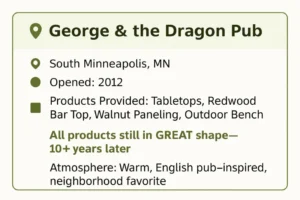 Every piece TimeWorn crafted for George & the Dragon is still in use today—more than a decade later—and in excellent condition. This proves that durability isn’t just a claim; it’s a long-term reality when you invest in premium materials, finishes, and craftsmanship.
Every piece TimeWorn crafted for George & the Dragon is still in use today—more than a decade later—and in excellent condition. This proves that durability isn’t just a claim; it’s a long-term reality when you invest in premium materials, finishes, and craftsmanship.
- Tables have survived over 10 years of daily service
- Finishes remain smooth and resilient against commercial cleaning
- Reclaimed materials tell a story while holding up under constant use
Why it Matters
- George & the Dragon demonstrates how the right tables and finishes are not just décor—they’re part of the experience. Every guest interaction, every plate served, and every drink poured happens on surfaces that remain beautiful, durable, and true to the restaurant’s story.
- This is the value of investing in TimeWorn: craftsmanship that doesn’t just open strong but continues to perform, year after year.
How to Order Restaurant Tabletops
Ready to elevate your space with TimeWorn’s handcrafted tabletops? Here’s the streamlined process from start to finish:
1. Initial Consultation
Start by reaching out via email or phone. Be ready to share your restaurant’s name, address, zip code (for shipping), desired tabletop styles (Classic, Butcher Block, Distressed, etc.), quantities, sizes, and your installation timeline. The more info we have upfront, the smoother and faster the process.
2. Samples & Quote
We’ll send you a detailed quote and a full-size 12″ × 12″ sample that represents the exact finish and thickness of your final product. Test it—place a hot dish, pour some wine, or wipe it with your cleaning methods to confirm it meets your expectations.
3. Contract & Down Payment
Once you’re ready to proceed, we’ll send a contract. Your order enters production once the signed contract and down payment are received. Remember, quoted lead times (e.g., 6 weeks) start only after this step.
4. Production
Your tabletops are meticulously crafted using solid wood, with moisture content at 6% or lower to prevent warping, cupping, or cracking—especially for quarter-sawn planks.
Once production starts, selections like sizes or finishes can’t be changed, so review your order carefully before approval.
5. Shipping
We coordinate delivery to your specified location. Given the size and weight of tabletops, shipping costs can rival the price of smaller orders—so confirming your order details beforehand ensures efficiency and avoids costly revisions.
6. Installation
Install your new TimeWorn tabletops and turn your vision into reality.
7. Share Your Results
We love seeing your space in action. Send us photos and feedback once your tables are installed so we can share your project with others.

FAQ
What sizes do restaurant tabletops come in?
Most restaurants use some common sizes, but we build everything custom, from two-tops to 14-foot communal tables. We also manufacture custom shapes (rounds, drop-leafs, booth cutouts, ADA tables) to fit your layout exactly.
What’s the best finish for daily cleaning?
Our industrial-grade acrylic polyurethane, SEFA-8 tested, Polarion, is the gold standard. It resists heat, alcohol, and chemicals while staying smooth and non-sticky under constant cleaning.
Do you ship nationwide?
Absolutely. We ship to all 50 states, Canada and most countries, with experience crating and delivering full truckloads safely to restaurants of every size.
Can I get samples before ordering?
Yes. Every order starts with a 12″×12″ full-thickness sample finished in the exact system we’ll use for your project. Test it with hot plates, red wine, or your cleaners before you commit.
How long does production take?
Most orders run on a 4-6 week lead time from signed contract and deposit. Rush orders or Quick-Ship options may ship faster.
Do you provide custom branding or engraving?
Yes. We can CNC-engrave your logo, add routed edge profiles, or match stains to your brand palette.
What’s your warranty policy?
Our finishes and construction are built for decades of service. If issues arise from manufacturing or material failure, we stand behind every table for a full 2 years but have stood behind our work for as long as 10 years if there was clearly a mistake on our part. Damage from improper cleaners or flipped chairs, however, falls outside warranty.
What’s the biggest mistake restaurants make with tables?
The first is flipping chairs upside down on tables during cleaning. This causes gouges, dents, and finish breakdown faster than anything else. Always store chairs on the floor or with protective padding. The second is using a cleaner with a sulfuric acid base.
Conclusion
When it comes to restaurant design, tabletops aren’t a side detail—they are the foundation of your guests’ dining experience. They influence first impressions, comfort, and even compliance with accessibility standards. Choosing the right material, finish, and design ensures that your investment lasts for years while consistently elevating your brand.
At TimeWorn, we’ve spent decades crafting commercial-grade solid wood tables that hold up in the toughest hospitality environments. From drop-leaf flexibility to bar tops over 14 feet long, our process combines U.S.-sourced hardwoods, precision CNC machining, and SEFA-8 tested finishes to deliver tables that perform as beautifully as they look.
If you’re ready to transform your dining space, we invite you to start with a full-size sample and a detailed quote. Experience the durability and craftsmanship that thousands of restaurants nationwide already trust—and see firsthand why TimeWorn remains the industry leader in handcrafted restaurant tabletops.

